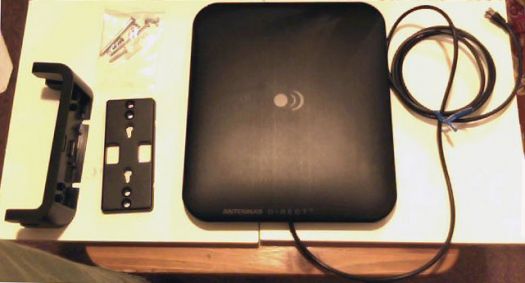With the advent of HDTV, a number of companies have sprung up specializing in the manufacture of "HDTV antennas" which they claim are "optimized" for HDTV reception. The implication, of course, is that traditional old-fashioned UHF/VHF antennas can't receive HDTV signals.
Better think again.
HDTV and DTV signals are broadcast entirely over standard UHF and Upper VHF bands, so those poor maligned rabbit ears gathering dust in your attic actually may do just fine at receiving them, as long as you're near the broadcast towers, and assuming your rabbit ears also include a UHF loop.
There is a chance that they won't cut it, though, depending on your proximity to the broadcast towers, any interfering structures between you and the broadcasting antennas, and the specific broadcast spectrum being used for DTV channels in your area. Before the digital transition, analog TV signals were broadcast mostly over VHF and only a little over UHF (at least the major network channels), and traditional rabbit ears, with their nifty telescoping VHF dipoles and cheap-looking wire UHF loop, were designed to accommodate that. Digital transmissions are mostly broadcast over UHF, with a little bit of upper VHF tossed in for good measure. Using your old rabbit ears to receive them could end up being like using a butterfly net to catch a grizzly bear -- not exactly your ideal tool for the job.

That's where Antennas Direct and their Clearstream line of HDTV antennas come into the *ahem* picture. Instead of reinventing the wheel, Antennas Direct has used computers and specialized algorithms to greatly refine antenna geometry. A quick look at the company's informative and well-designed website confirms that these babies aren't your grandma's antennas anymore. Rounded edges, wide, black, tapered surfaces, and in the case of the Clearstream Micron Long Range Indoor HDTV Antenna, the subject of this review, a compact design that could almost qualify as modern art. Yep, the Micron sure looks good. But does it deliver, enough to justify the manufacturer's suggested $49 price tag?
Out of the Box
Even the most pimped-out set of rabbit ears never won any prizes for design, but the Clearstream Micron is actually, uh, attractive. It is a compact, thin, black plastic square about 10 inches tall and 3/4" thick, tapering to 1/2" toward the edges. It comes with a stand/wall mounting bracket -- likewise a very simple U-shaped piece of black plastic. The basic kit also includes a set of directions, as well as all the screws and plugs needed to mount the Micron to the wall.

Installation
There are three options for installing the Clearstream Micron: a free-standing tabletop mount, flush wall mount, or raised wall mount. Which one you choose depends on where you get the best reception. The tabletop option is certainly the simplest: just place the base on a flat surface with its arms pointed upwards, snap the antenna into the notches provided on each arm specifically for that purpose, and you're good to go.
Wall installation is also quite simple: the most complicated part is determining what location has the best reception. Hopefully your TV or DVR has a signal strength meter so you can experiment with multiple locations. Once that potentially laborious process is done, the procedure for the flush and the raised mount is essentially the same: mark and drill mounting holes on the wall, screw mounting screws into the holes, then hang the antenna, either flush or raised. The only tools required are a drill, a screwdriver, a pencil and a level.
Clearstream Micron - a "Gain" in Performance?
Antennas Direct bills the Clearstream Micron as a "Long Range" antenna. The packaging that we received the antenna in calls it a "high gain" antenna. Ironically, in an article called "Don't Be Sold Based on Antenna Gain Alone" right on its own website, Antennas Direct says: "Gain is not the be-all and end-all of antenna design -- far from it, as any antenna engineer will tell you." Wait -- what??! So why exactly is "high gain" prominently scrawled all over the Clearstream Micron's packaging? Cynical marketing moves aside, perhaps an explanation of the term might help clear the airwaves.
Gain refers to an antenna's ability to focus scattered signals arriving from one particular direction into a single concentrated signal. A rough analogy would be a magnifying glass which concentrates scattered sunlight into a single beam, greatly increasing its power. Antenna gain is commonly expressed in deciBels(isotropic) or dBi - a comparison of the forward gain of an antenna to an omnidirectional isotropic antenna. Essentially, the higher the gain figure, the better the antenna's ability to focus incoming signals.
The trade-off with gain is that generally speaking, the higher the gain, the more directional an antenna is. The Micron's stated gain is 4.5 dBi; an "XG" version is available (with reflector) that boosts this all the way up to 8.5 dBi. This technically would classify it as "medium gain." And unlike super high gain antennas, the Micron has a reception beamwidth of 70 degrees which means it can pull in signals from a wider area and positioning of the antenna is slightly less critical. So, you may ask, if higher gain means an antenna is better at receiving a signal, then why not just buy a high gain antenna instead of a low or medium gain one?
First off, price. High gain antennas are usually more expensive than lower gain ones. The next important factor is size. High gain antennas are generally much larger than lower gain ones, which means a larger footprint in your home (or on your roof). Third, high gain is great if you receive all your DTV transmissions from a single source or broadcasting direction. But what if you're getting them from several different directions at once? In that case, you'd be better served with a multidirectional antenna that's good at simultaneously receiving signals from multiple directions, not just one direction at a time (or you could consider two high-gain antennas and a combiner, if you're trying to receive signals from two distant broadcast towers).
The final point to consider is distance. If you're pretty close to a broadcast tower, then a really high gain antenna might actually make matters worse, overloading your tuner with a signal that is too strong, or boosting multi-path distortion to the point that it interferes with the main broadcast signal. In short, you should take the "high gain" buzzword with a big grain of salt when considering an antenna purchase. The most important consideration in deciding whether or not to buy a particular antenna is where you are located relative to the nearest broadcasting towers. You can look up this information at site such as www.antennaweb.org or www.tvfool.org.

Antenna Smackdown -- Micron vs. Rabbit Ears
Although our apartment is only four miles from the Empire State Building, a complex of annoyingly large buildings across the street effectively blocks our direct line of sight to the transmitter, which reduces the available signal strength significantly. Through trial and error, we have discovered that our apartment's "sweet spot" for antenna reception is opposite a Manhattan-facing front window, about eight inches off the floor. Our antenna brouhaha consisted of placing first the Micron, then the rabbit ears in the sweet spot and checking their reception across all 41 available broadcast channels in our area. Antenna engineers, brace yourselves.
On the major UHF channels, which in our neighborhood translates to digital channels 2 through 5 and 17-68, the rabbit ears' flimsy wire loop and the Clearstream Micron's highly engineered element delivered nearly equal reception. On average, the Micron's signal was about 5% stronger than the rabbit ears on each of the major channels. The only channel where the rabbit ears' 5% deficit actually caused a bad picture was on channel 5 -- Fox -- whose signal strength in our neck of the woods tends to be low to begin with. But on the other channels -- CBS, NBC, ION and the Spanish broadcast channels among them -- the base signal was so strong that the 5% differential between the rabbit ears and the Micron caused no appreciable difference in picture quality.
Moving over to the upper VHF band, things got worse. In the sweet spot, the rabbit ears actually demonstrated a significant edge over the Clearstream Micron on a couple of the high VHF channels (digital channels 7.1 and 11.1) probably due to those pesky telescoping VHF elements on the rabbit ears. They delivered between 81 -- 93% signal strength on those channels, while the Micron could only muster a paltry 64%. If you know a thing or two about the Micron's design, this news actually should not be too shocking. It is designed primarily to receive signals in the UHF band and its upper VHF reception is nothing to write home about.
This observation necessitated moving the Micron to the floor (a step in the dreaded "antenna dance") where the signal strength immediately jumped to a quite acceptable 83-85%. Anyone who's ever owned a pair of rabbit ears will be only too familiar with the maddening antenna dance to find the ideal spot for reception. But if you're shelling out $49, at the very least one might expect the dance to be minimized, if not eliminated altogether. And in fact, once moved the Micron actually was able to bring in the high VHF channels -- including the hard-to-receive channel 13-1 (PBS) and its sub-bands -- requiring no supplemental fine tuning whatsoever. The same can't be said for the rabbit ears. The old war horse couldn't receive Channel 13 at all from the sweet spot, and even after a move to the floor it had to be "danced" into half a dozen positions before hitting on a consistent signal. Finally, it should be noted for the record that the Micron picked up a number of obscure channels which the rabbit ears didn't even attempt to receive. So what if no one in their right mind would ever think of watching them, unless they were tripping on acid? I didn't say that.
Turn-Ons
Turn-Offs
Final Thoughts
It's a bit disappointing that when placed in a situation that would appear ideally-suited to a medium to high gain antenna, the highly-engineered, well-marketed and attractive Clearstream Micron couldn't deliver a definitive TKO against a pair of plain old rabbit ears. The culprit here may be more the broadcast spectrum in use in New York City, but we would guess that other metropolitan areas will have their share of upper VHF channels as well, which may lead to similar results. Really, if you want to get the full spectrum of DTV channels, you'll be best served with a UHF antenna and a separate upper VHF antenna, such as Antennas Direct's own Clearstream C5 Digital VHF antenna. You can use a simple splitter/combiner to combine the signals of both antennas for best reception of all channels. But the C5 is rather large and is really best placed outdoors.
At least the "long range" designation isn't a total waste of money, as the Micron did evidence 5% stronger reception across the board on UHF channels and a pronounced ability to receive and hone in on signals that the rabbit ears had trouble with. This will certainly come in handy if you're a bit further out from your broadcast towers than we. Still, we're talking 49 bucks versus 12, and that kind of price differential leaves one aching for a more definitive and widely applicable result.
But rather than slamming Antennas Direct for inflating our expectations, a respectful nod to the broadcasting industry seems in order for developing digital signals so powerful that even a flimsy coathanger-wire UHF loop can receive them - at least the UHF ones, and if you're relatively close to the broadcast towers. In a world increasingly divided between haves and have-nots, digital broadcasting appears to be one of democracy's last holdouts. It's comforting to know that whether you spend $12 or $49, chances are you'll get acceptable results either way. So why not try out those rabbit ears first? If you're not satisfied, for an extra $37 the Micron offers good looks, an advantageous design and dependably solid reception. I, for one, chose to keep the Micron, and return the rabbit ears. It's not the Muhammad Ali of antennas, perhaps, but still recommended. And if you have trouble receiving the upper VHF signals, well they make antennas for that too.
*Epilogue: When Reception Dies, Accessorize!*
After we shared this review with Antennas Direct, they offered to send us two accessories specifically designed to improve the Clearstream Micron's reception and minimize the "antenna dance." The first, a reflector, consists of a perforated black metal panel which hooks onto the antenna's back like a miniature basketball backboard. The second, the Micron Variable In-Line Amplifier, is a small black plastic box the size of a thick IPod Touch which connects to the antenna/TV via two coaxial cables and has its own power supply and a touch-sensitive switch for adjusting the gain to settings ranging from +5dB to +20dB. The amplifier retails for $19.95 on the company's website; the reflector is not available separately but will soon be packaged together with the Micron as an option called the "XG Setup," no doubt at an increased price. We pimped our Micron out with these futuristic gadgets, then stuck it right back in the old sweet spot location to see if they improved reception of any of the problem channels -- namely Fox 5 (UF) and VHF channels 7-13.
Lo and behold: adding the reflector made a profound and instantly noticeable difference. Fox 5's signal, originally registering at 88-90% and plagued with frequent fluctuations and dropouts, abruptly stabilized at a whopping 93-96%, while reception of VHF channels 7-11 showed similar improvements. The notable exception was PBS Channel 13, which remained impossible to receive in the spot that worked well for all other channels. All it took, though, was a single, rather random "dance" to the floor, and channel 13 not only became visible but jumped to an astounding (for PBS) -- and stable -- signal strength of 90-91%.
Adding the amplifier to the mix finally allowed us to receive PBS in the sweet spot, without any fancy "dance" moves. Unfortunately, though, the amplifier exacted a high price for its services, actually worsening reception on several other key stations. And with PBS's signal strength in the sweet spot registering a none-too-impressive 80-81% even with the amplifier, we decided that compromising reception on the other major network channels was too high a price to pay for completely eliminating the "antenna dance".
The amplifier's failure to deliver an improved signal across the board can probably be traced to the fact that we are so close to the transmission towers that the signal was probably a bit too strong for our ATSC tuner, and this overload caused a drop in the tuner's performance. But the reflector appears to be a relatively low-tech and effective solution for boosting the Clearstream Micron's reception, at least in situations where an otherwise strong signal is disrupted by multipath distortion as is the case for us.
Features and Specifications of Antennas Direct Micron:
Manufacturer's contact info:
Antennas Direct
16388 Westwoods Business Park
Ellisville, MO 63021
1-877-825-5572
On the wab: www.antennasdirect.com
| Overall | |
|---|---|
| Value | |
| Performance | |
| Features/Ergonomics |